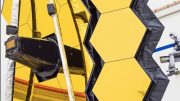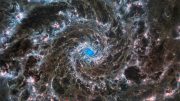The James Webb Space Telescope (Webb) will observe the Universe in the near-infrared and mid-infrared – at wavelengths longer than visible light.
By viewing the Universe at infrared wavelengths with an unprecedented sensitivity Webb will open up a new window to the cosmos. With infrared wavelengths it can see the first stars and galaxies forming after the Big Bang. Its infrared vision also allows Webb to study stars and planetary systems forming inside thick clouds of gas and dust that are opaque to visible light.
The primary goals of Webb are to study galaxy, star and planet formation in the Universe. To see the very first stars and galaxies that formed in the early Universe, we have to look deep into space to look back in time (because it takes light time to travel from there to here, the farther out we look, the further we look back in time).
The Universe is expanding, and therefore the farther we look, the faster objects are moving away from us, redshifting the light. Redshift means that light that is emitted as ultraviolet or visible light is shifted more and more to redder wavelengths, into the near- and mid-infrared part of the electromagnetic spectrum for very high redshifts. Therefore, to study the earliest star and galaxy formation in the Universe, we have to observe infrared light and use a telescope and instruments optimised for this light like Webb.
Star formation in the local universe takes place in the centres of dense, dusty clouds, obscured from our eyes at normal visible wavelengths. Near-infrared light, with its longer wavelength, is less hindered by the small dust particles, allowing near-infrared light to seep through the dust clouds. By observing the emitted near-infrared light we can penetrate the dust and see the processes leading to star and planet formation.
Objects of about Earth’s temperature emit most of their light at mid-infrared wavelengths. These temperatures are also found in dusty regions forming stars and planets, so with mid-infrared radiation we can see directly the glow of this slightly warm dust and study its distribution and properties.
Webb is an international partnership between NASA, the European Space Agency (ESA) and the Canadian Space Agency (CSA).













Be the first to comment on "Webb’s infrared universe"